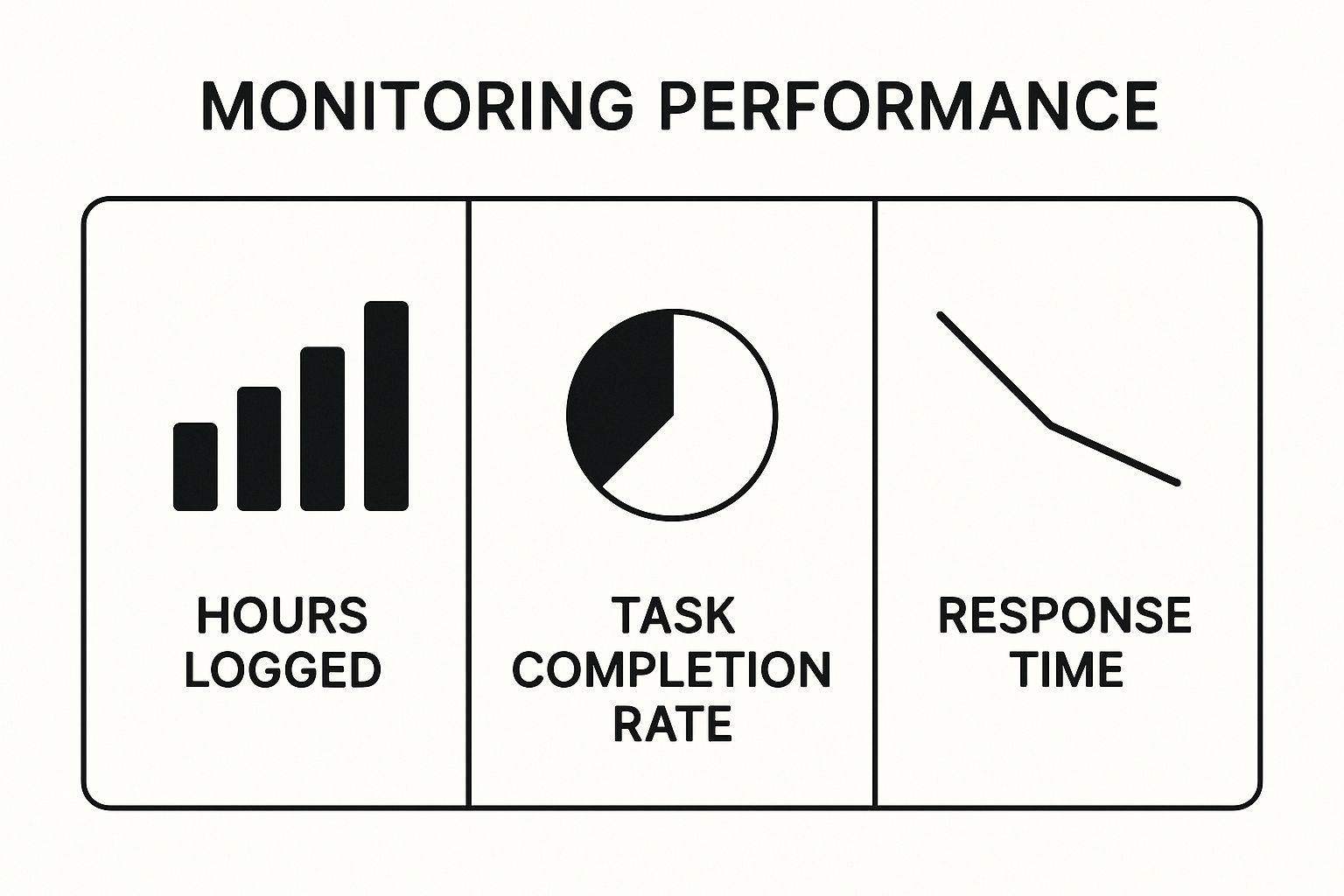How to Manage Remote Teams for Success

When you boil it down, successfully managing a remote team is all about building an intentional system around trust, clear communication, and outcome-driven work. It has far less to do with the number of virtual meetings you hold and everything to do with creating a structured environment where autonomy and connection can actually thrive, no matter where your people are.
The Modern Playbook for Remote Leadership

Let's be real—leading a remote team is way more than just sending a few Slack messages and hoping for the best. The old-school management playbook, with its reliance on "managing by walking around" or impromptu desk-side chats, just doesn't fly in a distributed world. To succeed, you have to deliberately shift your mindset from monitoring presence to measuring progress.
By 2025, this has become a non-negotiable skill. Remote work isn't a quirky trend anymore; it's a standard operating model. The numbers tell the story: 50% of remote-capable employees now work a hybrid schedule, 30% are fully remote, and only 20% remain fully on-site. This mix demands a more thoughtful and flexible approach to leadership.
This guide is designed to help you move past seeing remote work as a compromise and start treating it as a strategic advantage. Because when you get it right, distributed teams can be more productive, more engaged, and more diverse than their in-office counterparts.
Core Pillars of Remote Success
To make that happen, your leadership approach needs to be built on a few solid foundations. Think of these as the actionable principles that should guide every decision you make, not just a list of buzzwords.
Here's a quick overview of the pillars we'll be diving into.
Core Pillars of Modern Remote Management
This table breaks down the fundamental principles that are essential for any manager looking to build a high-performing distributed team.
| Pillar | Why It Matters | Key Action |
|---|---|---|
| Intentional Communication | Prevents misunderstandings and burnout. | Choose the right tool for the job and adopt an asynchronous-first mindset. |
| Outcome-Oriented Performance | Builds trust and empowers your team. | Shift focus from hours worked to results delivered. |
| Deliberate Culture Building | Fosters connection and psychological safety. | Proactively create opportunities for recognition and social interaction. |
| Strategic Technology Use | Reduces friction and enables collaboration. | Ensure your tech stack serves the team, not the other way around. |
These pillars aren't independent; they work together to create a cohesive and supportive remote work environment.
True remote leadership isn’t about trying to replicate the office online. It's about building a better, more inclusive, and more efficient way of working from the ground up.
Getting this right is a skill that blends empathy with structure. For a fantastic high-level look at the strategies involved, I highly recommend checking out these insights on mastering the art of managing remote teams.
In this guide, we’re going to break down each of these pillars into practical, real-world steps you can start using today. Honing these skills is a key part of your growth, and you can always build on them by exploring our guide on leadership development for managers. From setting up a communication system that actually works to measuring performance without micromanaging, you’ll get everything you need to lead your team with confidence.
Designing a Communication System That Works

We've all been there. The constant ping of notifications, a calendar packed with back-to-back video calls, and that nagging feeling you’ve missed a critical message. That’s not communication; it's a fast track to digital exhaustion and a surefire way to burn out your team.
The answer isn't more communication. It's smarter, more intentional communication. Managing a remote team effectively means building a deliberate architecture for how everyone interacts. It’s about moving past the "just use Slack for everything" mindset and creating clear guidelines that respect everyone's time and focus.
Synchronous vs. Asynchronous Communication
The biggest trap remote managers fall into is trying to perfectly replicate the in-office experience online. This almost always leads to a heavy reliance on synchronous communication—the kind that happens in real-time. Think video calls, instant messages where you expect an immediate reply, or that virtual "tap on the shoulder."
Asynchronous communication is the opposite. It’s when you don't need an instant response. This covers everything from email and comments in your project management tool to pre-recorded video updates. It gives your team the freedom to engage on their own schedule, which is crucial for deep work and navigating different time zones.
The goal isn't to eliminate synchronous communication, but to save it for what it does best: complex problem-solving, collaborative brainstorming, and building real connections. For just about everything else, default to asynchronous.
This shift in mindset is more important than ever. With nearly 60% of employers around the world now supporting fully remote setups, building robust and flexible communication systems is non-negotiable. You have to invest in the right async tools and, more importantly, set clear expectations for how to use them. For a deeper dive into this trend, check out We Work Remotely’s 2025 report.
Creating Your Communication Playbook
To put all this into practice, you need a playbook that spells out which tool to use for which purpose. This simple document eliminates confusion and frees up mental energy for your team, because they're not constantly trying to figure out where a conversation should happen.
Here’s a simple framework to get you started:
- For Urgent Issues: A designated Slack channel (like
#urgent) or a direct phone call. This is for true emergencies only, like a server going down. - For Quick Questions & Social Banter: General Slack or Teams channels are perfect for this. These are for the low-stakes, non-urgent chats that help keep the team connected.
- For Project Updates & Feedback: This belongs in your project management tool, like Asana or Trello. Keeping all project-related comms in one spot creates a clear, documented history.
- For Formal Announcements & External Communication: Good old-fashioned email is still king here. It provides a formal record and is the universal standard for talking to partners and clients.
By setting these clear "rules of the road," you empower your team to communicate effectively without constantly interrupting each other's flow.
Running Remote Meetings That Don't Drain Energy
Video calls are powerful, but they are also incredibly expensive—in both time and attention. The secret to great remote meetings is making every single minute count. The first step is to treat them as a last resort, not your go-to.
Before you hit "schedule," ask yourself one simple question: "Could this be an email, a Loom video, or a comment thread instead?" If you absolutely need a real-time discussion, make sure you follow these best practices:
- Always Have a Clear Agenda: Share it in advance with specific goals and talking points so everyone can come prepared.
- Assign a Facilitator: One person needs to own keeping the conversation on track and making sure everyone gets a chance to speak.
- End with Clear Action Items: Never leave a meeting without summarizing the decisions made and assigning the next steps with owners and deadlines. This is how conversations turn into actual progress.
Presenting your ideas clearly is a critical skill in a remote setting. If you or your team want to level up your impact in virtual meetings, our guide on how to improve presentation skills is a great place to start.
The Power of a Single Source of Truth
Finally, the absolute cornerstone of any great remote communication system is a single source of truth (SSOT). This is just a fancy way of saying you need a centralized, accessible knowledge base—like a company wiki in Notion or Confluence—that holds all of your important information.
Your SSOT should have everything from the company mission and values to detailed project plans and process documentation. When someone has a question, their first instinct should be to check the SSOT, not ping a colleague. This simple habit saves an incredible amount of time and gives your team the autonomy to find answers on their own.
When you're building out this system, choosing the right tools is key. To make sure your synchronous chats are as effective as possible, explore the best video conferencing software for remote work.
Building Your Remote Team's Tech Stack
Your team's tech stack is their digital office. It's where the work actually happens. When you get it right, everything feels seamless and collaboration just flows. But when you get it wrong, you’re basically introducing daily friction, confusion, and a whole lot of wasted time.
The trick isn't to just grab the most popular apps off the shelf. It’s about building a thoughtful toolkit that actually fits your team's specific workflow. Before you even think about brand names, you need to map out your core needs.
The Three Pillars of a Remote Tech Stack
I find it helpful to think of a good remote tech stack as having three distinct pillars. Each one solves a different, fundamental challenge of working from anywhere.
- Your Communication Hub: This is your virtual water cooler and open-plan office, all in one. It’s where the day-to-day pulse of the team lives. Tools like Slack or Microsoft Teams are perfect for those real-time chats, quick questions, and keeping the social fabric of the team strong.
- Your Project Management System: This is mission control. It's where you get total clarity on who is doing what and by when. Platforms like Asana, Trello, or Jira act as the single source of truth for every project's status, deadlines, and dependencies. No more "who's handling this again?" questions.
- Your Knowledge Base: Think of this as your company’s collective brain, accessible 24/7. A solid wiki or knowledge base—using something like Notion or Confluence—is a game-changer. It’s where you document processes and store key info so your team can find answers on their own instead of constantly pinging someone.
Once you have these categories in mind, you can start looking at specific tools based on how they fit into the bigger picture, not just on their flashy feature lists. A well-chosen tech stack will also give you the insights you need to track performance without feeling like you're micromanaging.

This kind of data helps you focus on what really matters—outcomes and results—instead of just tracking busywork.
How to Choose the Right Tools (Not Just the Popular Ones)
I’ve seen it time and again: a tool that works wonders for a tiny startup can absolutely cripple a 100-person team. Finding the best tool is way less important than finding the right tool for your specific crew.
A simple framework can make this decision a lot less painful. Before you commit to any new software, run it through these three critical questions:
- Does it play well with others? Your tools have to talk to each other. Can your project management app automatically fire updates into your main chat channel? The fewer things your team has to update manually, the better. Smooth integrations are non-negotiable.
- Is it actually easy to use? Be honest. If a tool is clunky or needs a week of training to understand, your team simply won't use it. At least not consistently. A clean, intuitive interface is everything if you want people to actually adopt the tool.
- Can it grow with us? Think about where your team will be in a year or two. Does the tool have a growth path? Choose software that can scale with you, whether that means offering more advanced features or simply handling more users without breaking a sweat.
To help you visualize your options, here’s a quick comparison of some popular tools that fit into the core categories we just discussed.
Remote Tech Stack Tool Comparison
| Tool Category | Popular Options | Best For |
|---|---|---|
| Communication Hub | Slack, Microsoft Teams, Google Chat | Teams needing real-time, channel-based chat and strong integration capabilities. |
| Project Management | Asana, Trello, Jira, Monday.com | Teams looking for visual task tracking, clear ownership, and deadline management. |
| Knowledge Base | Notion, Confluence, Slab, Guru | Documenting processes, creating an internal wiki, and centralizing company knowledge. |
| Video Conferencing | Zoom, Google Meet, Microsoft Teams | Reliable virtual meetings, screen sharing, and recording important conversations. |
| File Storage & Collab | Google Drive, Dropbox, OneDrive | Securely storing, sharing, and co-editing documents and files from anywhere. |
This isn't an exhaustive list, of course, but it gives you a solid starting point for building a stack that feels cohesive and purpose-built for your team.
Remember, the whole point of technology is to make life simpler, not to add another layer of complexity. A lean, tightly integrated stack of 3 to 5 core tools will almost always outperform a messy collection of a dozen disconnected apps.
By being deliberate about your choices, you build a digital headquarters that promotes clarity, focus, and autonomy for everyone on your team.
Creating a Remote Culture People Want to Join

A great company culture isn’t something that just happens because you have a well-stocked kitchen or cool office space. It’s built brick by brick through deliberate actions, shared values, and a whole lot of consistent effort. When your team is remote, that intentionality gets dialed up to eleven. You can't rely on hallway chatter to build a sense of belonging.
In a remote world, culture is the invisible glue holding everyone together. It’s the difference between someone feeling like a valued teammate versus just another name on a project plan. If you neglect it, you’re looking at higher turnover, sinking engagement, and a team that feels more like a loose collection of freelancers. Building it through a screen is a different ballgame, and it requires a new playbook.
Fostering Psychological Safety
The absolute bedrock of any strong remote culture is psychological safety. It’s that shared, unspoken belief that you can take risks without getting your head bitten off. Team members feel comfortable speaking up with a weird idea, asking a "stupid" question, or even admitting they messed up, all without fear of being shamed or punished.
When people feel safe, that's when the magic happens. Innovation sparks. People aren't afraid to say, "I'm totally lost on this," or "Hang on, I think there's a better way to do this." This kind of vulnerability is what stops tiny problems from snowballing into massive ones. And it’s even more critical remotely, where you can't just read the room to see if someone's holding back.
As a leader, you have to go first. Model the behavior. Kick off a meeting by sharing a small mistake you made recently and what you learned. When someone on your team points out a flaw in a plan, thank them publicly for their honesty. It sends a powerful message: we value your voice, even when it’s a dissenting one.
Beyond the Virtual Happy Hour
Let’s be real for a second: forced fun is rarely fun. Virtual happy hours had their moment in the sun, but for many, they’ve become just another Zoom meeting on an already packed calendar. Building real connections remotely is about creating opportunities for genuine interaction, not just staring at each other’s faces with a beverage.
Instead, think about activities that get people collaborating in a low-stakes, fun environment.
- Virtual Escape Rooms: These are brilliant because they require teamwork and creative problem-solving. You get to see different personalities shine.
- Collaborative Gaming: A quick session of an online game can do wonders for team morale. It’s less about winning and more about the banter and shared experience that happens along the way.
- Skill-Sharing Workshops: Ask your team! Someone might be an amazing photographer, a sourdough expert, or a whiz at building simple apps. Let them host a quick, informal session to share their passion.
The trick is to offer a mix of options and make them completely voluntary. This shows you respect people’s time and ensures that the folks who show up actually want to be there.
A thriving remote culture is measured not by the number of social events you host, but by the frequency of spontaneous, positive interactions that happen without a manager’s intervention.
This means you have to intentionally create the spaces where those organic moments can happen.
Engineering Spontaneous Connection
One of the biggest things we lost in the shift to remote work was the "water cooler" moment. You know, those unplanned chats that build real relationships. You can't perfectly replicate that serendipity, but you can definitely create digital spaces that come close.
A dedicated Slack or Teams channel is the obvious starting point. But for the love of all that is good, don't just call it #random. Give it some personality.
#pet-pics: An instant win. Who doesn't love seeing a coworker's dog in a silly hat?#what-im-reading: A fantastic way to uncover shared interests and kickstart conversations that go deeper than work.#wins-of-the-week: This is a space for people to brag a little, sharing small personal or professional victories that might otherwise go unnoticed.
These channels give your team permission to be human and connect on a level that has nothing to do with deadlines. To make it work, leaders need to jump in and participate, signaling that this kind of non-work chat isn't just tolerated, it's encouraged.
Building a Culture of Recognition
In an office, a quick "great job" as you walk past someone's desk can make their day. Remotely, that recognition has to be much more explicit and visible to land with the same impact. A simple, powerful tool for this is a peer-to-peer recognition program.
This doesn't have to be complicated or tied to money. In fact, genuine public praise often means more. Create a dedicated channel—we use #kudos—where anyone on the team can give a shout-out to a colleague for helping them out. This practice not only boosts morale but also shines a spotlight on the exact behaviors and values you want to see more of.
At the end of the day, building a remote culture people want to be a part of boils down to showing you care. It’s about creating an environment where people feel seen, heard, and valued—not just for the work they produce, but for the people they are.
Measuring Performance Without Micromanaging
One of the biggest anxieties for new remote managers is that nagging question in the back of your mind: "Is my team actually working?" It's tempting to try and replicate the office environment with surveillance software or constant Slack check-ins.
Let me tell you, that's a fast track to destroying trust and morale.
The real solution isn't about tracking every click. It's a fundamental shift in mindset from monitoring activity to measuring outcomes. When you get this right, you build a culture where autonomy and accountability go hand-in-hand. It’s about giving your team the freedom to do their best work, on their own schedule, while providing absolute clarity on what success looks like. You become a coach, not a watchdog.
The modern workplace has already made this shift. Post-pandemic, remote and hybrid work is here to stay, with about 35%-40% of employees working from home at least one day a week. This new normal demands that managers focus on results, not just physical presence. You can dig into more of the data on this new equilibrium over at Global Workplace Analytics.
Shift From Hours Logged to Outcomes Achieved
The first, most critical step is to completely untether "time at the keyboard" from your idea of productivity. In a results-oriented work environment (ROWE), the only thing that matters is the output. Did the project hit its goals? Was the work delivered on time and up to standard?
This approach is incredibly empowering for your team. It sends a clear message: "I trust you to manage your time and energy to produce great work." It also respects different working styles. Some people are sprinters, knocking out incredible work in focused, two-hour bursts. Others are marathoners, preferring a steady pace throughout the day. Who cares, as long as the work gets done?
To make this shift work, you have to be crystal clear about what you're measuring.
- Project Milestones: Break down big, intimidating projects into smaller, trackable achievements. This makes progress visible for everyone and helps you spot potential roadblocks before they become serious problems.
- Key Performance Indicators (KPIs): Every role should have clear, quantifiable metrics. For a writer, this might be articles published. For a developer, it could be features shipped or bugs squashed.
- Customer Satisfaction: For anyone in a client-facing role, metrics like Net Promoter Score (NPS) or direct customer feedback are powerful, undeniable indicators of performance.
The Power of OKRs in a Remote Setting
A fantastic framework I’ve used to set these kinds of clear, ambitious goals is Objectives and Key Results (OKRs). It's a deceptively simple system for getting your entire team aligned around what truly matters.
Here’s how it works: An Objective is what you want to achieve—it should be aspirational and a little bit exciting. The Key Results are how you'll measure your progress toward that objective. They have to be specific, measurable, and time-bound. No wiggle room.
For instance:
- Objective: Become the go-to resource in our industry this quarter.
- Key Result 1: Publish 12 high-quality, research-backed blog posts.
- Key Result 2: Increase organic search traffic by 20%.
- Key Result 3: Secure three guest post placements on industry-leading blogs.
OKRs are a remote manager's best friend because they provide ultimate clarity without dictating the "how." You're giving the team a destination and trusting them to figure out the best route to get there. Of course, knowing what to measure is a skill in itself, and our guide on measuring content performance can give you some great ideas.
Master the Art of the Remote One-on-One
Regular one-on-one meetings are the heartbeat of great remote management. This is your dedicated, sacred time to connect with each person on your team individually. But please, don't use this time to ask for a laundry list of status updates—that’s what Asana or Jira is for.
The most effective remote one-on-ones are forward-looking conversations focused on removing roadblocks and supporting professional growth, not backward-looking interrogations about what got done.
Think of these as supportive coaching sessions. Here's a simple agenda that works wonders.
A Simple One-on-One Agenda
- Their Topics First (10 mins): I always start by asking, "What's on your mind?" This gives them ownership of the meeting and ensures we tackle their most pressing concerns first.
- Roadblocks & Challenges (10 mins): Next, "What's getting in your way?" Your main job as a manager is to be a roadblock remover. This is where you find out what those roadblocks are.
- Growth & Development (5 mins): Talk about career goals, skills they want to build, and how you can help them get there.
- Feedback & Alignment (5 mins): This is your time to offer specific, constructive feedback and make sure you're both aligned on priorities for the week ahead.
This structure transforms a boring status report into a high-value strategic conversation. It’s how you build trust, keep your team engaged, and ensure everyone is moving in the right direction.
A Few Common Remote Management Questions Answered
Even when you have the perfect strategy on paper, the day-to-day of managing a remote team throws some curveballs. Theory is one thing, but you need practical answers when you're in the thick of it. This is where we get into the nitty-gritty, tackling those common "what do I do when..." scenarios that every single remote manager runs into sooner or later.
We’re going to move past the high-level ideas and get straight to the advice you can use today. Whether you're trying to bring a new hire into the fold from miles away or juggling a team scattered across the globe, these answers should help you lead with a bit more confidence.
How Do You Onboard New Hires Remotely?
Onboarding is your golden opportunity to get a new person plugged into your company culture. Doing it remotely means you have to be way more intentional and structured about it. A great remote onboarding is so much more than just shipping a laptop and a list of logins; it’s about making someone feel like they truly belong from the moment they sign their contract.
Your process should kick off before their first official day. A simple welcome package with some company swag, their new equipment, and a clear schedule for their first week goes a long way. It’s a small gesture that says, "We're excited you're here, and we're ready for you."
For those first couple of weeks, prioritize connection over contribution. Here’s how:
- Give Them an Onboarding Buddy: Pair them up with a peer who isn't their direct manager. This creates a safe space for them to ask all the "silly" questions they'd be too nervous to ask you.
- Schedule Intentional Social Time: Set up a few short, informal virtual coffee chats with people on the team and even in other departments. The only agenda is getting to know each other as people, not just as colleagues.
- Create a "First 30 Days" Roadmap: Hand them a clear document that outlines what’s expected, who they should meet, and what small wins they can aim for. This cuts down on first-month anxiety and gives them a clear path forward.
What’s The Best Way To Manage Different Time Zones?
Running a team spread across multiple time zones feels like a logistical nightmare, but if you get it right, it can be a massive strategic advantage. The secret? Make asynchronous communication your default setting. This simple shift respects everyone's local working hours and stops people in later time zones from constantly feeling like they’re playing catch-up.
Try to establish a small window of "core collaboration hours"—maybe just two or three hours a day—where everyone's schedules overlap. Protect this time fiercely and use it only for the essential stuff, like a team sync or a critical brainstorming session.
Your goal isn't to force everyone into the same 9-to-5 schedule. It's to build a system where the work keeps moving forward 24/7 without burning anyone out. A well-oiled global team never really shuts down for the day.
Document absolutely everything in a shared knowledge base. When your London team signs off, they should be able to drop detailed notes into a tool like Asana or Notion, allowing the San Francisco team to pick things up without missing a beat.
How Do You Prevent Remote Employee Burnout?
Remote work has a nasty habit of blurring the lines between your job and your life, which makes burnout a very real, very serious risk. As a manager, you have to be the one who actively models and enforces healthy boundaries. It’s not enough to just say, "Don't work late"—your team needs to see you living it.
Here are a few practical ways to fight back against burnout:
- Lead by Example: Stop sending emails or Slack messages after hours. If an idea hits you late at night, write it out, but schedule it to send the next morning. Your team will follow your lead.
- Encourage "Time Off" Transparency: Get your team into the habit of blocking out lunch breaks, appointments, and focus time on their public calendars. This normalizes taking breaks and makes it obvious when someone is off-limits.
- Run Regular "Workload Audits": In your one-on-ones, don't be afraid to ask direct questions about workload and stress. Something as simple as, "What can we push back to make room for this new project?" shows that you see their time as a finite, valuable resource.
At the end of the day, preventing burnout is all about creating a culture where rest is understood to be a critical part of being productive, not a sign of weakness.
Creating powerful, engaging content is key to building your brand, and that's where Lumeo comes in. Our AI-powered platform helps you transform any piece of content—from a simple tweet to a detailed article—into stunning, shareable carousels for LinkedIn, Instagram, and more. Stop letting your best ideas get lost in the feed. Start creating visual assets that capture attention and drive real results. Discover how easy it can be at https://lumeo.me.